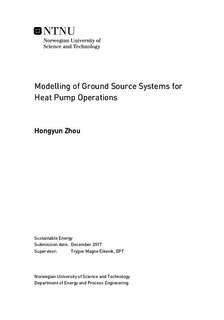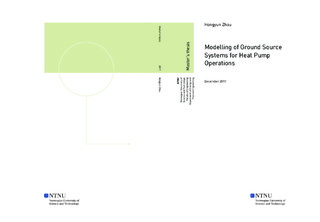| dc.description.abstract | This thesis concerns the regional hydraulic and thermal interference between well doublets of ground source heat pump systems. The thesis falls into three parts of which the first focus on theoretical review of operating mechanism and available modelling methodology of ground source heat pump systems. The second part emphasize on establishing appropriate model to reflect the interference with experimental data collected from real sites at city Melhus, Norway. The third and last part involves a test for validation and simulation result analysis for drawing suggestions to help mitigate the negative interference between wells doublets. The essence of the thesis is described hereunder, starting with the ground source heat pump systems.
A Ground source heat pump (GSHP) system migrates the heat from the outdoor circuit to the air conditioning and hot water terminal of indoor circuit through a circular operation of refrigerant circuit. Groundwater heat pump (GWHP) systems, as an open-loop subclass of Ground source heat pump systems take aquifers as a storage of thermal energy. The system operates by drawing water from an abstraction well, passing it through a heat exchanger and discharging it into nearby infiltration well.
From the point of either users or regulatory authority, ground source heat pump systems have incomparable advantages over conventional heating approaches in reproducibility, energy conservation, environmental friendliness, versatility and long service life. Likewise, groundwater source heat pump systems also yield a higher performance efficiency and lower operation cost than Air source heat pump (ASHP) systems. To help achieve a higher overall efficiency during the systems service life, numerous models have being proposed by researchers to predict the thermal response under different design parameters and groundwater flow conditions.
As for city Melhus, wells for groundwater source heat pump system are sporadically distributed in its urban area. Meanwhile the geological condition of layer of aquifers in Melhus fits the case of unconfined aquifers and strata structure could be simplified into five major layers according to predominating constituent of each layer. A numerical model was therefore established by software Feflow on the basis of parameters collected from samples at city fire station.
Validation was conducted and the outcomes were compared to theoretical and experimental data. Series of 10-year simulations were performed. Simulations disclosed the pros and cons of multiple means of figuring out hydraulic and thermal breakthrough time, two crucial indicators to reflect the moment when overall efficiency of the system begins to deteriorate. Besides, the outcomes also revealed to which extent breakthrough time and system s overall efficiency could be affected by altering the external factors used as independent variables of input. It was found that:
Placing the abstraction well up the hydraulic gradient from the infiltration well thus forming a contrary flow would produce a 3.4% increment in thermal breakthrough time as compared to same hydraulic gradient s case and placing it down the hydraulic gradient would produce a 2.9% depletion on thermal breakthrough time in contrast. Doubling the speed of groundwater flow would yield a 3.3% increment in thermal breakthrough time. Reducing the abstraction rate or hydraulic conductivity by half would generate a 107.5%, 80.2% increment in thermal breakthrough time, representing a negative correlation. From this point of view, abstraction rate along with hydraulic conductivity proves to play more significant a role in affecting breakthrough time than direction or speed of groundwater flow.
In addition to breakthrough time, the same factors also contribute to the movement of turning point for operational efficiency. Meanwhile, setting the abstraction point higher than or at least at the same depth of injection level would gain a long-term advantage over setting it 5 meters below the injection level. Factors like direction and speed of groundwater flow contributes limited influence while abstraction rate and hydraulic conductivity both would incur a remarkable shift on transient and overall efficiency turning point. Compared to a normal service life of the groundwater source heat pump system, users are only required to make a trade-off between short-term and long-term efficiency only if the abstraction rate is smaller than 7.5L per second or the specific horizontal hydraulic conductivity is below 0.002m/s.
Furthermore, users are recommended to turn the GWHP system into intermittent operation. Put the system in operation in an intermittent manner would significantly raise the ending temperature at the end of each operation cycle by 0.2-0.4 degrees Celsius and substantially delay the breakthrough. Meanwhile, intermittent operation also contributes to a postpone of the turning point of the overall efficiency. Under such circumstance, users are more likely to be obliged to choose between the short-term and long-term efficiency. | |

